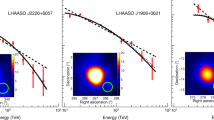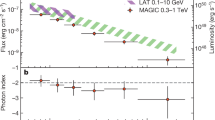Abstract
The source of Galactic cosmic rays (with energies up to 1015 eV) remains unclear, although it is widely believed that they originate in the shock waves of expanding supernova remnants1,2. At present the best way to investigate their acceleration and propagation is by observing the γ-rays produced when cosmic rays interact with interstellar gas3. Here we report observations of an extended region of very-high-energy (> 1011 eV) γ-ray emission correlated spatially with a complex of giant molecular clouds in the central 200 parsecs of the Milky Way. The hardness of the γ-ray spectrum and the conditions in those molecular clouds indicate that the cosmic rays giving rise to the γ-rays are likely to be protons and nuclei rather than electrons. The energy associated with the cosmic rays could have come from a single supernova explosion around 104 years ago.
This is a preview of subscription content, access via your institution
Access options
Subscribe to this journal
Receive 51 print issues and online access
$199.00 per year
only $3.90 per issue
Buy this article
- Purchase on Springer Link
- Instant access to full article PDF
Prices may be subject to local taxes which are calculated during checkout



Similar content being viewed by others
References
Ginzburg, V. L. (ed.) Astrophysics of Cosmic Rays (North Holland, Amsterdam, 1990)
Hillas, A. M. Can diffusive shock acceleration in supernova remnants account for high-energy galactic cosmic rays? J. Phys. G 31, R95–R131 (2005)
Aharonian, F. Gamma rays from molecular clouds. Space Sci. Rev. 99, 187–196 (2001)
Hofmann, W. in Proc. 28th ICRC, Tsukuba 2811–2814 (Univ. Academy Press, Tokyo, 2003)
Hunter, S. D. et al. EGRET observations of the diffuse gamma-ray emission from the galactic plane. Astrophys. J. 481, 205–240 (1997)
Aharonian, F. A. et al. Very high energy gamma rays from the direction of Sagittarius A*. Astron. Astrophys. 425, L13–L17 (2004)
Tsuchiya, K. et al. Detection of sub-TeV gamma-rays from the Galactic Center direction by CANGAROO-II. Astrophys. J. 606, L115–L118 (2004)
Kosack, K. et al. TeV gamma-ray observations of the Galactic Center. Astrophys. J. 608, L97–L100 (2004)
Aharonian, F. A. et al. Very high energy gamma rays from the composite SNR G0.9 + 0.1. Astron. Astrophys. 423, L25–L29 (2005)
Aharonian, F. A. et al. The H.E.S.S. survey of the Inner Galaxy in very high energy γ-rays. Astrophys. J. (in the press) preprint at http://arXiv.org/astro-ph/0510397 (2005)
Tsuboi, M., Toshihiro, H. & Ukita, N. Dense molecular clouds in the Galactic Center region I. Observations and data. Astrophys. J. Suppl. 120, 1–39 (1999)
Oka, T. et al. A large-scale CO survey of the Galactic Center. Astrophys. J. Suppl. 118, 455–515 (1998)
Crocker, R. M. et al. The AGASA and SUGAR anisotropies and TeV gamma rays from the Galactic Center: A possible signature of extremely high energy neutrons. Astrophys. J. 622, 892–909 (2005)
Maeda, Y. et al. A Chandra study of the Sagittarius A east: A supernova remnant regulating the activity of our Galactic Center? Astrophys. J. 570, 671–687 (2002)
Rockefeller, G. et al. The X-ray ridge surrounding Sgr A* at the Galactic Center. Astrophys. J. (submitted); preprint at http://arXiv.org/astro-ph/0506244 (2005)
Aharonian, F. & Neronov, A. TeV gamma rays from the Galactic Center. Space Sci. Rev. (in the press); preprint at http:arXiv.org/astro-ph/0503354 (2005)
Bélanger, G. et al. A persistent high-energy flux from the heart of the Milky Way: INTEGRAL's view of the Galactic Center. Astrophys. J. (in the press); preprint at http://arXiv.org/astro-ph/0508128 (2005)
Crutcher, R. M. Magnetic fields in molecular clouds: observations confront theory. Astrophys. J. 520, 706–713 (1999)
Morris, M. & Serabyn, E. The Galactic Center environment. Annu. Rev. Astron. Astrophys. 34, 645–701 (1996)
Mattox, J. R., Hartman, R. C. & Reimer, O. A quantitative evaluation of potential radio identifications for 3EG EGRET sources. Astrophys. J. Suppl. 135, 155–175 (2001)
Aharonian, F. A. et al. A new population of very high energy gamma-ray sources in the Milky Way. Science 307, 1938–1942 (2005)
Aharonian, F. A. et al. High-energy particle acceleration in the shell of a supernova remnant. Nature 432, 75–77 (2004)
Aharonian, F. A. et al. Detection of TeV gamma-ray emission from the shell-type supernova remnant RX J0852.0-4622 with HESS. Astron. Astrophys. 437, L7–L10 (2005)
Pierce-Price, D. et al. A deep submillimeter survey of the Galactic Center. Astrophys. J. 545, L121–L125 (2000)
Dahmen, G. et al. Molecular gas in the Galactic center region II. Gas mass and N H 2 / I 12 C O conversion based on a C18O(J = 1 → 0) survey. Astron. Astrophys. 331, 959–976 (1998)
Lis, D. C. & Goldsmith, P. F. CO isotope studies and mass of the Sagittarius B2 molecular cloud. Astrophys. J. 337, 704–711 (1989)
Acknowledgements
The support of the Namibian authorities and of the University of Namibia in facilitating the construction and operation of HESS is gratefully acknowledged, as is the support by the German Ministry for Education and Research (BMBF), the Max Planck Society, the French Ministry for Research, the CNRS-IN2P3 and the Astroparticle Interdisciplinary Programme of the CNRS, the UK Particle Physics and Astronomy Research Council (PPARC), the IPNP of Charles University, the South African Department of Science and Technology and National Research Foundation, and by the University of Namibia. We would like to thank M. Tsuboi for providing the CS survey data used here and Y. Moriguchi and Y. Fukui for helpful discussions on molecular tracers.
Author information
Authors and Affiliations
Corresponding author
Ethics declarations
Competing interests
Reprints and permissions information is available at npg.nature.com/reprintsandpermissions. The authors declare no competing financial interests.
Supplementary information
Supplementary Notes
This file contains the Supplementary Discussion, Supplementary Methods and additional references. (DOC 26 kb)
Rights and permissions
About this article
Cite this article
Aharonian, F., Akhperjanian, A., Bazer-Bachi, A. et al. Discovery of very-high-energy γ-rays from the Galactic Centre ridge. Nature 439, 695–698 (2006). https://doi.org/10.1038/nature04467
Received:
Accepted:
Issue Date:
DOI: https://doi.org/10.1038/nature04467
This article is cited by
-
A GeV-TeV particle component and the barrier of cosmic-ray sea in the Central Molecular Zone
Nature Communications (2021)
-
How to distinguish an actual astrophysical magnetized black hole mimicker from a true (theoretical) black hole
Astrophysics and Space Science (2021)
-
High-Energy Particles and Radiation in Star-Forming Regions
Space Science Reviews (2020)
Comments
By submitting a comment you agree to abide by our Terms and Community Guidelines. If you find something abusive or that does not comply with our terms or guidelines please flag it as inappropriate.



